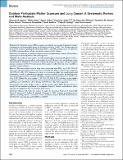| dc.identifier.citation | Hamra, G. B., N. Guha, A. Cohen, F. Laden, O. Raaschou-Nielsen, J. M. Samet, P. Vineis, et al. 2014. “Outdoor Particulate Matter Exposure and Lung Cancer: A Systematic Review and Meta-Analysis.” Environmental Health Perspectives 122 (9): 906-911. doi:10.1289/ehp/1408092. http://dx.doi.org/10.1289/ehp/1408092. | en |
| dc.description.abstract | Background: Particulate matter (PM) in outdoor air pollution was recently designated a Group I carcinogen by the International Agency for Research on Cancer (IARC). This determination was based on the evidence regarding the relationship of PM2.5 and PM10 to lung cancer risk; however, the IARC evaluation did not include a quantitative summary of the evidence. Objective: Our goal was to provide a systematic review and quantitative summary of the evidence regarding the relationship between PM and lung cancer. Methods: We conducted meta-analyses of studies examining the relationship of exposure to PM2.5 and PM10 with lung cancer incidence and mortality. In total, 18 studies met our inclusion criteria and provided the information necessary to estimate the change in lung cancer risk per 10-μg/m3 increase in exposure to PM. We used random-effects analyses to allow between-study variability to contribute to meta-estimates. Results: The meta-relative risk for lung cancer associated with PM2.5 was 1.09 (95% CI: 1.04, 1.14). The meta-relative risk of lung cancer associated with PM10 was similar, but less precise: 1.08 (95% CI: 1.00, 1.17). Estimates were robust to restriction to studies that considered potential confounders, as well as subanalyses by exposure assessment method. Analyses by smoking status showed that lung cancer risk associated with PM2.5 was greatest for former smokers [1.44 (95% CI: 1.04, 1.22)], followed by never-smokers [1.18 (95% CI: 1.00, 1.39)], and then current smokers [1.06 (95% CI: 0.97, 1.15)]. In addition, meta-estimates for adenocarcinoma associated with PM2.5 and PM10 were 1.40 (95% CI: 1.07, 1.83) and 1.29 (95% CI: 1.02, 1.63), respectively. Conclusion: The results of these analyses, and the decision of the IARC Working Group to classify PM and outdoor air pollution as carcinogenic (Group 1), further justify efforts to reduce exposures to air pollutants that can arise from many sources. Citation: Hamra GB, Guha N, Cohen A, Laden F, Raaschou-Nielsen O, Samet JM, Vineis P, Forastiere F, Saldiva P, Yorifuji T, Loomis D. 2014. Outdoor particulate matter exposure and lung cancer: a systematic review and meta-analysis. Environ Health Perspect 122:906–911; http://dx.doi.org/10.1289/ehp.1408092 | en |


